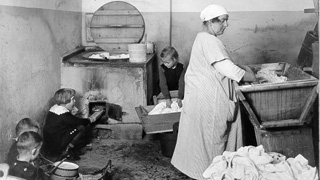Growth of the City - History of Vienna
The growth of the urban area combined with the concurrent increase in population figures and the economic change produced a growing divergence between the originally close link between the work and home spheres. It required the government to launch programmes for the development of a public transport system. This was a relatively new phenomenon in the urban fabric. But it had been anticipated in some way by interregional transport made possible when steamship navigation and railways emerged. Interestingly enough, the introduction of the first horse-drawn trams in Vienna was motivated by other considerations - to wit, a desire to make the scenic surroundings of Vienna accessible to the people. Soon, however, the new mass transit system became indispensable to large segments of the population. Towards the late 19th century, the so-called metropolitan railway system was built, its lines linking the suburbs. The course of these lines had been made possible by the dismantling of the last remaining fortifications, the above-mentioned Linienwall. Initially, the system was operated with steam and, later on, after World War I, with electricity. The trams had been electrified as early as around 1900.
Housing
Generally speaking, the construction sector enjoyed a veritable boom in Vienna during the second half of the 19th century. However, it was not spared collapse in some areas, in the wake of the severe economic crisis at the time of the 1873 World Exposition in Vienna. It is interesting to note in this context that housing construction and housing in general was a field entirely controlled by private enterprise. The German term "Gründerzeit" - literally translated, it means "age of the founders" - is an appropriate and eloquent description thereof. The tenant was very largely dependent on the private landlord. This resulted in major inadequacies and severe shortcomings. A typical feature of the period was the flat whose kitchen was directly entered from the corridor. It had neither a water tap of its own nor a bathroom or toilet. Running water had to be fetched from the communal tap in the corridor outside the flat, the so-called "Bassena", from Italian "bacino". The often exorbitant rents gave rise to another social phenomenon, that of the "Bettgeher". The tenants of a flat sublet beds for the night/day to people who were unable to afford a flat of their own.
This housing situation was particularly widespread in the suburbs, i.e. the districts that were incorporated in 1850. Quite a number of these houses have survived. We also see certain patterns, with some districts having always been associated with the upper echelons of society. Mention should be made here, for instance, of the 4th district, Wieden, with its concentration of embassies or the 8th district, Josefstadt, with a more well-to-do segment of residents of notaries public, lawyers and senior civil servants. Outside the city, in the more rural suburbs, veritable high-quality residential neighbourhoods prevailed even as early as the second half of the 19th century.
Urban Growth
The urban area and the outskirts - they formed part of the province of Lower Austria at the time - converged more and more. Many of the problems were difficult or even impossible to solve for the communities on their own because their fiscal revenue was simply not enough. This situation was perceived as increasingly harmful. The result was another wave of incorporations, this time of communities south of the Danube, from 1890 to 1892. During the first decade of this century (1904), another community, Floridsdorf, became part of Vienna. It lay north of the Danube and had seen a terrific economic upswing, thanks to the machine manufacturing industries located there.
Population figures in Vienna had continued to rise rapidly, not only as a result of the incorporations, but also as a result of the massive influx into the capital of the Austro-Hungarian monarchy. We have on record the tallies of the regular censuses since 1869. In 1880, the city had had 726,000 inhabitants, by 1890 their number had grown to 1,365,000 - thanks to the incorporation of the suburbs. By 1910 the city reached the highest figure in its history, with 2,031,000. By comparison, London boasted 7.25 million by 1910, Paris 2.85 million and Berlin 2.07 million.
Development of infrastructure
This increase went hand in hand with mounting demands on the urban infrastructure which had to be met once again around the turn of the century after the construction of the metro railway system and of the Second Vienna Spring Water Main. Now the city government set about to operate the most important technical services and utilities itself, "deprivatising" many hitherto private enterprises. This was true in particular of the transport sector as well as the electricity and gas utilities. These programmes, which had been intended, among other things, as sources of municipal revenue, triggered a rapid increase of expenditures. Most of the budget was spent (in this order) on education, debt service, roads and streets, general administration, welfare and water supply.
It should be noted that all these programmes also reflected the profound change that was taking place in terms of more participation in the political life of the country of more segments of the population. The late 19th century had seen a major extension of the right to vote in general - it had been "decoupled" from tax payments (1907: men's suffrage, 1919: women's suffrage) - as well as, at the same time, the emergence and rise of mass parties. These included in particular the Christian Socialist movement, which was the strongest party until the end of the monarchy in 1918, and the Social Democrats, whose rise began with the end of the First World War.
City of Vienna | Municipal and provincial archives of Vienna
Contact form

